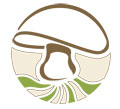Micheldever: Dodsley Wood
Sat 22 Sep 2007
Field event ID HF0718
OS Grid areas: SU5337 SU5338
Weather: There had been some light rain in the preceding week but the day itself was warm, overcast and dry.
Report: Dodsley Wood is a new area of the woods around Micheldever for the HFRG to visit and was recommended by one of the members after a productive visit last year. Dodsley Wood itself is at the far end of the woods from the car park and we managed to walk the necessary mile without being distracted by fungi on the way! The centre of Dodsley Wood is a beech plantation but around the edges were many older trees including many large specimens of Hornbeam and Field Maple. The ground in the wood did feel slightly damper than of late but was certainly not showing signs of significant rain. During the morning we found a few agarics including the Lactarius blennius lookalike L fluens with the cap showing a paler edge, more yellow tones and without the water droplets. During lunch Alan, never one to miss an opportunity, rolled over a log and found a magnificent display of green tinted resupinate Ceriporiopsis pannocincta (Green porecrust) which soon brought out everyone's cameras! Sara showed us Uromyces muscari which although apparently present on most bluebells has only been recorded once by the group before.I am sure this occurs with many small fungi and I remember Martyn Ainsworth telling us last year that Ascodichaena rugosa should be reported on nearly all forays but never is. Near the end of the day growing on a fallen beech log was Ganoderma pfeifferi (Beeswax bracket) and Mycoacia nothofagi (Fragrant toothcrust) with it's distinctive sweet soapy oily smell, you have to smell it really. These two along with the C pannocincta are three of the thirty quality beech wood indicator species. Finally just before returning to the cars Alan spotted several specimens of a Collybia but so far this has eluded final identification and has been dried and saved for the future.
Species list: Ampulloclitocybe clavipes, Annulohypoxylon multiforme, Armillaria bulbosa, Armillaria ostoyae, Biscogniauxia nummularia, Bjerkandera adusta, Boletus chrysenteron, Calocera viscosa, Ceriporiopsis pannocincta, Chlorociboria aeruginascens, Cudoniella acicularis, Daedalea quercina, Daedaleopsis confragosa, Daldinia concentrica, Datronia mollis, Diatrype disciformis, Fuscoporia ferrea, Fuscoporia ferruginosa, Ganoderma australe, Ganoderma pfeifferi, Gloeocystidiellum porosum, Gymnopus confluens, Henningsomyces candidus, Heterobasidion annosum, Hymenochaete corrugata, Hymenochaete rubiginosa, Hyphodontia barba-jovis, Hypholoma fasciculare var. fasciculare, Hypoxylon fragiforme, Hypoxylon fuscum, Hypoxylon rubiginosum, Junghuhnia nitida, Kuehneromyces mutabilis, Lactarius blennius, Lactarius fluens, Lactarius vellereus, Lycoperdon pyriforme, Marasmius rotula, Megacollybia platyphylla, Mutinus caninus, Mycena haematopus, Mycoacia nothofagi, Peniophora laeta, Peniophora quercina, Peniophorella praetermissa, Peniophorella pubera, Phallus impudicus var. impudicus, Phanerochaete laevis, Phanerochaete sordida, Phlebia livida, Phlebia rufa, Phlebia tremellosa, Phlebiella sulphurea, Physisporinus sanguinolentus, Piptoporus betulinus, Pluteus cervinus, Polyporus leptocephalus, Polyporus squamosus, Polyporus tuberaster, Russula aeruginea, Russula aurora, Russula chloroides, Russula cyanoxantha, Russula farinipes, Russula nigricans, Russula nobilis, Russula ochroleuca, Schizopora paradoxa, Skeletocutis nivea, Steccherinum fimbriatum, Steccherinum ochraceum, Stereum hirsutum, Stereum rameale, Stereum rugosum, Stereum subtomentosum, Suillus grevillei, Trametes gibbosa, Trametes versicolor, Uromyces muscari, Vuilleminia comedens, Xerula radicata, Xylaria carpophila, Xylaria hypoxylon, Xylaria polymorpha
